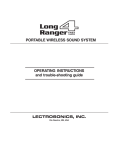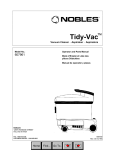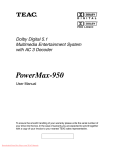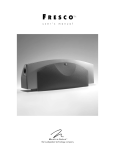Download Band Shoppe LONG RANGER IV Operating instructions
Transcript
LONG RANGER IV: OPERATING INSTRUCTIONS & TROUBLESHOOTING GUIDE INTRODUCTION Thank you for selecting the Long Ranger portable wireless sound system. This unique design combines a rechargeable power supply, a high-power amplifier and loudspeaker and high quality VHF wireless microphone into a single compact assembly. The design has evolved with numerous refinements since its first predecessor was introduced in the early 1980’s to serve public address applications indoors and outdoors, with the ruggedness and reliablity needed for professional use. A single Long Ranger provides enough output power to cover surprisingly large outdoor areas as a stand-alone unit. Versatile options and accessories expand the use of the Long Ranger to handle unusual coverage areas with the addition of external loudspeakers. Optional accessories also include an additional wireless microphone, hard-wired microphone, tape recorder, CD player, etc. Two Long Ranger systems can be interconnected with a single cable to allow multiple microphones and other audio sources to use both systems simultaneously, operating together as though they are a single sound system. TABLE OF CONTENTS INTRODUCTION ....................................................................................................................................................................................... 1 GENERAL TECHNICAL DESCRIPTION ......................................................................................................................................................... 2 RECHARGEABLE BATTERIES AND EXTERNAL POWER SOURCES .................................................................................................................. 2 CONTROLS AND FUNCTIONS .................................................................................................................................................................... 3 CONTROL PANEL ...................................................................................................................................................................... 3 FRONT PANEL .......................................................................................................................................................................... 4 SYSTEM SETUP RULES ............................................................................................................................................................................. 5 INITIAL EQUIPMENT ADJUSTMENTS .......................................................................................................................................................... 5 USING ADDITIONAL SPEAKERS ................................................................................................................................................................. 7 ADDING A SECOND WIRELESS CHANNEL TO YOUR LONG RANGER .............................................................................................................. 8 INITIAL ADJUSTMENTS TO THE ADD-ON RECEIVER SYSTEM ....................................................................................................................... 9 SPECIAL NOTE TO DUAL-CHANNEL USERS ................................................................................................................................................. 9 MULTIPLE LONG RANGER SYSTEMS ........................................................................................................................................................ 10 MICROPHONE CHOICES ......................................................................................................................................................................... 11 ACCESSORIES AND REPLACEMENT PARTS .............................................................................................................................................. 12 SPECIFICATIONS ................................................................................................................................................................................... 12 TROUBLESHOOTING ............................................................................................................................................................................... 13 SERVICE AND REPAIR ............................................................................................................................................................................ 14 RETURNING UNITS FOR REPAIR ............................................................................................................................................................. 14 WARRANTY ........................................................................................................................................................................................... 15 1 F I R S T P L A C E S TA RT S H E R E ™ PH 800.457.3501 • BANDSHOPPE.COM UPDATED 10.07.2004 LONG RANGER IV: OPERATING INSTRUCTIONS & TROUBLESHOOTING GUIDE GENERAL TECHNICAL DESCRIPTION The standard Long Ranger Portable Wireless Sound System consists of a combination wireless receiver/amplifier/speaker with a rechargeable battery pack, a belt-pack or plug-on transmitter and a microphone. Optional microphones, extension speakers and add-on equipment for a second wireless channel are available. The Long Ranger features a VHF wireless microphone system with a transmitter-to-receiver operating range of up to 750 feet. The receiver is designed for high selectivity to prevent interference from other transmitted radio signals. The system is designed and constructed for rigorous portable use with the antenna integrated into the horn speaker to eliminate damage. The Long Ranger will operate from 8 to 12 hours from the “on-board” rechargeable battery pack before recharging is necessary. The actual operating time is dependent upon the type of usage...intermittent or continuous. The unit can also be operated from an external 12 Volt DC source or an AC wall outlet. The amplifier produces 33 Watts, RMS, into the 8 Ohm horn speaker. The sound output will cover an area the size of a football field under average outdoor conditions. Several Long Rangers can be easily connected together to provide even greater area coverage. RECHARGEABLE BATTERIES AND EXTERNAL POWER SOURCES The built-in battery pack in the Long Ranger is charged by plugging the DCR15/2AU charger into the jack labeled DCR15/2AU CHARGER on the control panel. Connect the charger into a standard 110 or 220 Volt AC outlet. (The DCR15/2AU charger can be operated from 110/220V, 50/60Hz.) The green lamp beneath the jack will light as long as the batteries are charging. When the batteries are almost completely charged the green charging light will go out. You may leave the charger plugged in after the green light has gone out with no danger of damage to the system. In fact, we recommend charging the system whenever it is not in use, then the system will always be “ready to go”. The DCR15/2AU charger can charge the batteries in as little as 2 ½ hours. If the unit is completely run down, it may require as much as 6 hours to fully charge the batteries. Leave the charger plugged in at least until the green lamp below the CHARGER jack goes out. NOTE: In the case of severely discharged batteries (this can happen if the Long Ranger has been left on constantly for several months), it may be neccessary to charge the unit for a much longer time. Up to 10 days charge time is not uncommon in these circumstances. The DCR15/2A charger is capable of charging the batteries and running the Long Ranger in normal operation at the same time. The time required to fully recharge that batteries will be longer if the unit is being used while charging the battery pack. CAUTION! USE ONLY THE SUPPLIED DCR15/2A CHARGER DO NOT USE THE OLDER CH40 CHARGER IN THE NEW LONG RANGER 4. THE CH40 WILL NOT CHARGE THE BATTERIES IN THE LONG RANGER 4 AND WILL BE DAMAGED IF USED. The Long Ranger can be operated from an external 12 Volt DC source such as an automobile battery or, most commonly, from the cigarette lighter receptacle in your vehicle. To use an external power source it must be connected into the 12V DC POWER INPUT jack on the Long Ranger front panel. CAUTION–Make sure you comply with the polarity markings on the jack. The correct plug for making the connection is a Radio Shack 274-1567 size K coaxial DC power plug. Radio Shack also stocks cigarette lighter plugs (with built-in fuse) and cords to construct a suitable assembly. 2 F I R S T P L A C E S TA RT S H E R E ™ PH 800.457.3501 • BANDSHOPPE.COM UPDATED 10.07.2004 LONG RANGER IV: OPERATING INSTRUCTIONS & TROUBLESHOOTING GUIDE CONTROLS AND FUNCTIONS: CONTROL PANEL WIRELESS MICROPHONE VOLUME Turns unit power on and off and also functions as the volume control for the internal wireless receiver. POWER A red LED that lights when unit power is on. RF A green LED that lights when the companion transmitter is turned on and there is sufficient signal for good system operation. Internal circuits monitor both signal level and interference levels and decide if the transmitted signal is strong and “clean” enough for satisfactory operation. If not, the green RF LED will go out and the receiver will mute the audio (“squelch”), turning off the sound output. This action is automatic and requires no user adjustments. MOD LEVEL The red and green MOD LEVEL LEDs continuously indicate the modulation level (audio level) of the received signal from the transmitter and are used when making intial adjustments to the transmitter. MIC This connector is a standard ¼” phone jack and is used for plugging in the cord from a low impedance dynamic microphone. LINE This mini jack is used for connecting high level, high impedance outputs from tape decks or other amplifiers. It also may be used for connecting the “earphone” output from portable cassette players. AUXILIARY INPUT VOLUME Adjusts the volume of the MIC and LINE inputs. AUX IN/OUT An RCA phone jack that functions both as a line level input and line level output. This “omnibus” jack is primarily used for interconnecting several Long Rangers together for simultaneous operation. This jack can also be used with a tape deck to either record from or play back into the Long Ranger. When used with a tape deck or other audio source, the sound output level must be controlled by the volume control on the tape deck since there is no volume control on the Long Ranger for the AUX IN/OUT jack. When an external device is connected to this jack, the loudness of the Long Ranger will usually be reduced. DCR15/2AU CHARGER A special jack used for connecting the charger when charging the battery pack. The green LED located under the jack lights when the batteries are charging. This LED automatically goes out when the batteries are almost fully charged. 12V DC OUTPUT A special jack used to supply power to the Add-On receiver when that option is installed. 3 F I R S T P L A C E S TA RT S H E R E ™ PH 800.457.3501 • BANDSHOPPE.COM UPDATED 10.07.2004 LONG RANGER IV: OPERATING INSTRUCTIONS & TROUBLESHOOTING GUIDE CONTROLS AND FUNCTIONS: FRONT PANEL 12V DC EXT POWER A special jack used to connect an external 12 Volt DC source to the unit to substitute for the “on-board” battery pack. It is most commonly used for connecting the Long Ranger to a vehicle cigarette lighter or 12V DC auxillary receptacle. When an external power source is connected to this jack, the on-board battery pack is automatically disconnected. Connectors and power supply cables are available from electronics parts suppliers such as Radio Shack. EXTERNAL 8 OHM SPEAKERS Two jacks which are used to connect external 8 ohm loudspeakers such as the Lectrsonics H300 re-entrant horn. This jack can also be used to power other brands of loudspeakers, but be sure that the speaker has a rated impedance of 8 ohms. The left-hand jack disconnects the built-in horn when the plug is inserted. The right-hand jack will operate the internal horn along with the external speaker. The efficiency of different makes and models of speakers varies significantly. Even though two different speakers are both rated at 8 ohms, their loudness could be quite a bit different. The other specification to compare when considering the use of another speaker is the efficiency rating. The horn built into the Long Ranger is rated at 107 dB SPL (sound pressure level) at one meter with a one watt input. Check this specification on the speaker you are considering. A speaker with a lower “dB’ number will not be as loud as the horn built into the Long Ranger. 4 F I R S T P L A C E S TA RT S H E R E ™ PH 800.457.3501 • BANDSHOPPE.COM UPDATED 10.07.2004 LONG RANGER IV: OPERATING INSTRUCTIONS & TROUBLESHOOTING GUIDE SYSTEM SETUP RULES This section includes some basic rules that will ensure trouble-free operation of your Long Ranger system. 1. Make sure the transmitter battery is good, or better yet, new. 2. Charge up the battery pack in the Long Ranger fully before you use the system. Charge until the green charging lamp underneath the CHARGER jack on the Long Ranger control panel goes out. 3. Set up the system so that the Long Ranger is as far from large metal surfaces as possible. Metal surfaces under the unit (such as pickup truck cabs or a car top) are generally no problem but large metal surfaces alongside the Long Ranger may interfere with wireless reception. 4. If you have more than one transmitter on the same frequency, turn on only one transmitter at a time. You cannot use two transmitters at the same time with a single Long Ranger. You will need to “alternate” back and forth between the transmitters. Failure to do so will result in an obnoxious whining sound from the system, and the audio will probably not be understandable. “Add-on” wireless mic systems are available separately to permit operation of two transmitters simultaneously through a single Long Ranger. 5. Use the minimum volume that will enable everyone to hear. It doesn’t have to be loud to be heard. 6. Always turn the power off before connecting or disconnecting external speakers. 7. The Long Ranger should be elevated for best coverage. The unit should ideally be at least 2 feet higher than the audience. For example, with an audience standing on flat ground, the number of people that can hear clearly will double if you raise the unit from 5 feet above the ground to 7 feet ablove the ground. 8. During actual operation the Long Ranger should be located at least 20 feet away from the person using the microphone and aimed so that the sound from the speaker is directed toward the audience and away from the microphone. This will reduce feedback problems. “Feedback” is a loud squealing sound coming from the speaker when the volume is too high or the microphone is too close to the Long Ranger. Feedback is generally much more of a problem when using lavalier (lapel) type microphones. The headset models are recommended for use with the Long Ranger system since they place the microphone pickup much closer to your mouth, which increases the loudness of the Long Ranger before feedback occurs. INITIAL EQUIPMENT ADJUSTMENTS This section covers the initial adjustments to the transmitter and Long Ranger that must be made before the system is placed into operation. The step-by-step procedures are listed in the order in which they should be performed: 1. Turn Long Ranger power on – The POWER lamp lights. 2. 3. 4. 5. 6. Rotate both volume controls counter-clockwise to their minimum settings. Position yourself behind the Long Ranger so that the sound from the speaker will be directed away from the microphone. Plug your microphone into the transmitter. Rotate the plug clockwise to make sure the connection is locked. Turn the transmitter power on and verify that the red lamp on it lights. If the lamp is very dim or does not light, replace the battery. Observe that the green RF lamp on the Long Ranger control panel is lighted. This verifies that the unit is receiving a usable signal from the transmitter. 7. Position the microphone on yourself (or other user) in the location it will be during actual operation. If you are using the single-band or dual-band headset microphone, turn the white knob on the headset fully clockwise (maximum). The HM162 over-ear microphone should be positioned so that the pickup element is just to the left of the mouth, so that breath pops do not strike the capsule. Lavalier microphones should be positioned high on the chest or collar, as close to the mouth as possible to minimize the possibility of “feedback.” 5 F I R S T P L A C E S TA RT S H E R E ™ PH 800.457.3501 • BANDSHOPPE.COM UPDATED 10.07.2004 LONG RANGER IV: OPERATING INSTRUCTIONS & TROUBLESHOOTING GUIDE 8. A small screwdriver is supplied with the transmitter. The screwdriver is used to adjust the audio gain of the transmitter to match your microphone and your voice. The adjustment is made while observing the MOD LEVEL lamps on the Long Ranger control panel: a. Speak at the voice level you will be using during actual operation. b. While speaking, adjust the transmitter gain with the screwdriver until the green MOD LEVEL lamp on the Long Ranger control panel is lighted or flickers and the red MOD LEVEL lamp blinks on the loudest words. Raise and lower your voice while observing the lamps. The red lamp should blink occasionally. 9. Now adjust the WIRELESS MICROPHONE VOLUME control on the control panel to a level where everyone can hear. You will probably have to do this in several steps. If you attempt to adjust the volume yourself while standing and just behind the unit, you will likely have a “feedback” problem. It is convienient to have another person adjust the volume while you transmit from a position 20 feet or more behind the unit. REMEMBER – the transmitter gain control (the screwdriver adjustment) is used only to adjust for proper MOD LEVEL lamps indications. DO NOT use it to adjust the output volume of the Long Ranger speaker. Different voices and different microphones will usually require readjustment of the transmitter gain control, so check the adjustment frequently. If several different people will be using the system and there is not time to make the adjustment for each individual, adjust it for the loudest voice. 6 F I R S T P L A C E S TA RT S H E R E ™ PH 800.457.3501 • BANDSHOPPE.COM UPDATED 10.07.2004 LONG RANGER IV: OPERATING INSTRUCTIONS & TROUBLESHOOTING GUIDE USING ADDITIONAL SPEAKERS CAUTION! ALWAYS TURN THE LONG RANGER POWER OFF BEFORE PLUGGING IN OR UNPLUGGING EXTERNAL SPEAKERS In some cases, the proper coverage of an audience requires a second speaker. The optional H300 is identical to the Long Ranger speaker and can be used to spread the sound over a broader area. The output jacks for external speakers are located on the Long Ranger front panel. The left and right jacks operate differently. The right jack does not disconnect the built-in speaker when a plug is inserted into it. This means that the built-in speaker and the external speaker will both operate together. The left output jack disconnects the built-in speaker and powers only the external speaker. Internal circuits and switching networks keep track of the number of speakers hooked up and select the amplifier impedance so that the full power of the amplifier is always available. It is important that you use only an 8 Ohm speaker in these jacks. If you are not using Lectrosonics extension speakers, check the speaker for the proper rating before connecting to the Long Ranger. The efficiency of different makes and models of speakers varies significantly. Even though two different speakers are both rated at 8 ohms, their loudness could be quite a bit different. The other specification to compare when considering the use of another speaker is the efficiency rating. The horn built into the Long Ranger is rated at 107 dB SPL (sound pressure level) at one meter with a one watt input. Check this specification on the speaker you are considering. A speaker with a lower “dB’ number will not be as loud as the horn built into the Long Ranger. The H300 speaker is typically used in conjunction with the built-in speaker to increase the sound-coverage area. This is done by plugging the H300 into the right speaker jack, so that both speakers will work together. In a large area, such as a football field, try to arrange the speakers so that the listeners are not in the direct sound field of both speakers. If a listener can hear two speakers located at different distances, a distrancting “echo effect” occurs. Put the speakers close to one another in a central location and aim them in opposite directions to broaden the coverage pattern. When using two external speakers simultaneously, the built-in speaker will be automatically disconnected to prevent overload of the amplifier since a plug has been inserted into the left-hand jack. 7 F I R S T P L A C E S TA RT S H E R E ™ PH 800.457.3501 • BANDSHOPPE.COM UPDATED 10.07.2004 LONG RANGER IV: OPERATING INSTRUCTIONS & TROUBLESHOOTING GUIDE ADDING A SECOND WIRELESS CHANNEL TO YOUR LONG RANGER A very popular feature of the Long Ranger is the ability to add a second wireless channel to an existing system in the field. The Lectrosonics Add-On Receiver system was expressly designed for that purpose. The standard system consists of an Add-On receiver, an M175 transmitter and a microphone. The Add-On receiver is supplied with velcro attaching strips and is equipped with the necessary cabling for making the connections to the Long Ranger. The receiver is installed on the Long Ranger by performing the following steps as shown in Figure 4: 1. The antenna cable for the Add-On is packed together with screws, lock washers and the velcro strips. The antenna cable is terminated with two ring lugs. Feed the lug end of this cable through the hole in the Long Ranger rear panel upright. Dress the cable along the top of the battery pack along with the speaker wires as shown in Figure 4. 2. Remove and discard the two black Phillips head screws from the bottom of the antenna strip on the right-hand side of the speaker and from the speaker mounting block. Using the supplied bright screws and lockwashers, connect the shield ring lug (the black wire) to the speaker mounting block. Connect the center conductor ring lug (the clear/white wire) to the antenna. Tighten both screws securely. 3. The Add-On receiver is to be mounted on the Long Ranger upright with velcro. The receiver should be positioned, control panel up, between the horn mounting screw and the screw which secures the battery pack to the upright. Remove the paper backing from one side of the velcro and affix it to the back of the receiver. Remove the remaining paper backing and affix the receiver to the upright. 4. Route the antenna cable through the hole in the rear upright panel, above the battery pack so that the black and white wires reach the speaker mounting block. Connect the remaining two cables to the 12V DC OUTPUT jack and the LINE input jack on the control panel. 8 F I R S T P L A C E S TA RT S H E R E ™ PH 800.457.3501 • BANDSHOPPE.COM UPDATED 10.07.2004 LONG RANGER IV: OPERATING INSTRUCTIONS & TROUBLESHOOTING GUIDE INITIAL ADJUSTMENTS TO THE ADD-ON RECEIVER SYSTEM 1. Set up the Long Ranger system according to the Initial Equipment Adjustments on page 5. 2. Leave the Long Ranger power turned on. Set both volume controls on the Long Ranger control panel to minimum. 3. Turn the Add-On receiver power switch to “ON.” Check to see that the power lamp comes on. 4. Plug the microphone into the transmitter that is on the same frequency as the Add-On receiver. The plug on the microphone is a twist-lock connector. Make sure there is a good connection. If you are using the headset microphone, turn the white level control knob on the headset fully clockwise (maximum). 5. Install the 9 Volt battery into the transmitter, turn the transmitter on and make sure the red LED on the transmitter glows brightly. 6. Check to see that the green “RF” LED on the Add-On receiver glows steadily. This verifies that the receiver is picking up a good radio signal from the transmitter. 7. This is the most important step in the set up procedure. Place the microphone in the exact position where you will be using it. Speak at the same voice level that you will use during actual operation. While you speak, use the supplied screwdriver to adjust the gain control on the tranmitter side panel (see page 6) while you observe the MODULATION LEDs on the Add-On receiver front panel. The green LEVEL lamp should flicker or stay lit as you speak. The red LIMIT lamp should blink only on louder words. 8. Adjust the AUXILIARY INPUT VOLUME control on the Long Ranger control panel for the necessary loudness. If the transmitter gain controls have been correctly set on both the Long Ranger 4 and the Add-On system, both volume control knobs on the Longer Ranger 4 panel will be in about the same position for equal loudness on both systems. It is not unusual, however, that one of the volume controls may need to be set higher or lower than the other one in normal use. Adjust the controls separately for adequate sound levels for each microphone. SPECIAL NOTE TO DUAL CHANNEL USERS If you are only using one of the two wireless systems, it is best to use the wireless system built into the Long Ranger and leave the Add-On receiver turned off. This will prevent unwanted noise, hiss or static that could occur in the unused receiver from entering the Long Ranger. If it is necessary to use the Add-On receiver by itself, turn the WIRELESS MICROPHONE VOLUME control knob on the Long Ranger control panel to minimum. Then set the AUXILARY INPUT VOLUME for the necessary loudness of the Add-On system. 9 F I R S T P L A C E S TA RT S H E R E ™ PH 800.457.3501 • BANDSHOPPE.COM UPDATED 10.07.2004 LONG RANGER IV: OPERATING INSTRUCTIONS & TROUBLESHOOTING GUIDE MULTIPLE LONG RANGER SYSTEMS A unique use of the AUX IN/OUT jack is for connecting two Long Ranger systems together for simultaneous use. When connected in this manner, they will operate like a single system. It is best to use two different Long Ranger units that operate on different frequencies. Any input on either Long Ranger will appear at both speakers. If the Long Ranger systems are on the same frequency, only one transmitter can be used at any given moment. Second channel (add-on) wireless systems on either (or both) Long Ranger systems will work fine, as long as they are all on different frequencies. Each wireless microphone will have its own volume control. The built-in wireless in each Long Ranger will be controlled by the left-hand knob on the matching unit. The volume of each add-on wireless system will be controlled by the right-hand knob on the matching unit. All sound from all wireless microphones will appear on all loudspeakers, both built-in or external. Connect the Long Ranger systems together with a standard RCA (phone) patch cord, male plug to male plug. It is best to use cords 10 to 12 ft. in length (or less) to minimize noise that can occur with long cables. If any of the Long Rangers or add-on wireless system are on the same frequency, only one transmitter can be used at a time on that frequency. REMEMBER that if two transmitters on the same frequency are turned on at the same time, the receiver will not receive either of them properly. You will need to “alternate” the use of the same transmitters. The INITIAL EQUIPMENT ADUSTMENTS (see page 6) should be performed on each system individally before the AUX IN/OUT interconnection is made. After the units are connected together, adjust the volume on each Long Ranger for the loudness level needed. 10 F I R S T P L A C E S TA RT S H E R E ™ PH 800.457.3501 • BANDSHOPPE.COM UPDATED 10.07.2004 LONG RANGER IV: OPERATING INSTRUCTIONS & TROUBLESHOOTING GUIDE MICROPHONE CHOICES M119 This is a very small, omni-directional mic used only as a lavalier (“lapel”) microphone. It may be prone to feedback since it is usually placed so far away from the users mouth; however it has a very flat response and excellent tone quality. The M119 generally works best with the Long Ranger and an ES300 column speaker indoors at a lower volume setting. As is true of most omni-directional type microphones, the M119 is very free from wind noise and clothing “rattle”. M140 A cardioid (directional) microphone for lavalier (“lapel”) use. Due to the directional pickup pattern, this model will generally provide more gain (loudness) before feedback than the M119 omni-directional model. The M140 has a “brighter” sound than the M119 (the treble is boosted). This crisper sound normally improves the clarity that is sometimes lost with lavalier type microphones. The M140 is subject to wind noise and generally works best indoors, however it is supplied with a foam windscreen which helps to prevent noise caused by wind. HM142V This single-band headset microphone is normally worn on the head, but can also be worn around the neck for hands-free operation. It provides maximum gain before feedback since the microphone is very close to the user’s mouth. The built-in volume control helps control feedback in difficult environmens, such as when the user must be close to the Long Ranger. Worn on the head, the microphone will remain at a constant distance from the user’s mouth, which keeps the volume of the sound system constant as your head moves. HM152V A double-band headset microphone intended to be worn on the head. The pickup element and tonal characteristics are the same as the single-band HM142V, but it is more securely mounted and in most cases, more comfortable, due to the fully adjustable dual headband. The same volume control is provided to help control feedback. HM162 A “over the ears” noise cancelling microphone that uses a dual-element design to minimize feedback when the microphone is close to the speaker. Other brands of microphones may be used, provided they are the correct type, with an appropriate connector. Consult the factory or your dealer is you are not sure. A mis-matched microphone will generally cause background noise (hiss) or feedback problems, or may not work at all. 11 F I R S T P L A C E S TA RT S H E R E ™ PH 800.457.3501 • BANDSHOPPE.COM UPDATED 10.07.2004 LONG RANGER IV: OPERATING INSTRUCTIONS & TROUBLESHOOTING GUIDE ACCESSORIES AND REPLACEMENT PARTS DCR15/2AU HM142V HM152V HM162 Battery Charger Single Headband Double Headband “Over ears” Headset MC-16C MC-44 MM-36 RK-51 RK-119 RK-142 Microphone Cord Microphone Cord Patch Cord Wind Screen Wind Screen Wind Screen Replacement With locking micro plug for M175 series transmitters. Double adjustable headband. With micro plug Headset Microphone for M175 series transmitters. A comfortable headworn design that places the microphone pickup element close to the mouth, using a dual-element, noise cancelling technique to minimize feedback. 16 ft. coil cord (¼" male to male) for M121S ¼" male to locking micro male; adapts M121S to M175 36" RCA (male to male) for interconnecting AUX IN/OUT jacks. For M121S microphone For M119 and M140 microphones HM142V and HM152V headset microphones CCPRO SS-5 Carrying Case Tripod Stand Molded, pre-cut foam lined 2-section legs, riser column; 59" max. height SPECIFICATIONS (subject to change without notice) Operating frequency: Audio power output: Distortion: Amplifier freq. response: Overall freq. response: Max. audio output (SPL): FM deviation: Wireless operating range: 169 to 186 MHz 33 Watts, RMS, into 8 Ohms less than 1% 100 Hz to 15 kHz; +0, -3 dB (Omnibus jack input to external speaker jack output.) 200 Hz to 3 kHz; +0/-3 dB (Wireless input to horn output.) Over 120 dB at 3 feet ±15 kHz Up to 750 feet RF signal-to-noise ratio: Speaker: Weight: Dimensions: 96 dB, A weighted 6" x 12" re-entrant horn 16 lbs. 15" high, 6 ¾" wide, 9 ¾" deep 12 F I R S T P L A C E S TA RT S H E R E ™ PH 800.457.3501 • BANDSHOPPE.COM UPDATED 10.07.2004 LONG RANGER IV: OPERATING INSTRUCTIONS & TROUBLESHOOTING GUIDE TROUBLESHOOTING SYMPTOM POSSIBLE CAUSE Long Ranger red POWER lamp not on or dim 1. WIRELESS MICROPHONE VOLUME control in OFF position 2. Batteries completely discharged 3. Battery terminals disconnected or loose Long Ranger green RF lamp not on 1. Transmitter not on 2. Dead battery in transmitter 3. Transmitter and receiver not on same frequency Long Ranger red POWER lamp and green RF lamp on, but no sound A) MOD LEVEL lamps dark B) MOD LEVEL lamps indicating System operation normal except for high hiss or hum level A) Green MOD LEVEL lamp dark or barely flickers B) MOD LEVEL lamps appear normal 1. Transmitter is not getting an audio signal. Defective mic or cable. 2. Transmitter gain control set much too low 1. WIRELESS MICROPHONE VOLUME control normal turned completely down 2. Defective horn or speaker 1. Transmitter gain control set too low 2. Headset volume (white knob) turned down 1. Noisey microphone or mic cable? To verify, replace with known good microphone. 2. Hiss in device connected to Long Ranger? Turn off the device. If hiss stops, problem is in the device. If hiss remains, the problem is in the Long Ranger. 3. Hiss in the Long Ranger can be caused by poorly shielded computers, phone systems, older electronic organs, etc. Try turning off nearby suspect equipment. System operation normal except for “feedback” and/or red MOD LEVEL lamp on or blinking frequently 1. Transmitter gain set too high. 2. Output level of device connected is too high. Weak, distorted sound. Power lamp flickers. “Motorboating” (rapid popping sound.) Batteries very low. Recharge. 13 F I R S T P L A C E S TA RT S H E R E ™ PH 800.457.3501 • BANDSHOPPE.COM UPDATED 10.07.2004 LONG RANGER IV: OPERATING INSTRUCTIONS & TROUBLESHOOTING GUIDE SERVICE AND REPAIR If your system malfunctions, you should attempt to correct or isolate the trouble before concluding that the equipment needs repair. Make sure you have followed the setup procedure and operating instructions. Check out the interconnecting cords and then go through the TROUBLE SHOOTING section in the manual. We strongly recommend that you do not try to repair the equipment yourself and do not have the local repair shop attempt anything other than the simplest repair. If the repair is more complicated than a broken wire or loose connection, send the unit to the factory for repair and service. Don’t attempt to adjust any controls inside the units. Once set at the factory, the various controls and trimmers do not drift with age or vibration and never require readjustment. There are no adjustments inside that will make a malfunctioning unit start working. LECTROSONICS’ service department is equipped and staffed to quickly repair your equipment. In warranty repairs are made at no charge in accordance with the terms of the warranty. Out of warranty repairs are charged at a modest flat rate plus parts and shipping. Since it takes almost as much time and effort to determine what is wrong as it does to make the repair, there is a charge for an exact quotation. We will be happy to quote approximate charges by phone for out-of-warranty repairs. RETURNING UNITS FOR REPAIR You will save yourself time and trouble if you will follow the steps below: A. DO NOT return equipment to the factory for repair without first contacting us by letter or by phone. We need to know the nature of the problem, the model number and the serial number of the equipment. We also need a phone number where you can be reached 8 am to 4 pm (Mountain Standard Time). B. After receiving your request, we will issue you a return authorization number (R.A.). This number will help speed your repair through our receiving and repair departments. The return authorization number must be clearly shown on the outside of the shipping container. C. Pack the equipment carefully and ship to us, shipping costs prepaid. If necessary we can provide you with the proper packing materials. UPS is usually the best way to ship the units. Heavy units should be “double-boxed” for safe transport. D. We also strongly recommend that you insure the equipment, since we cannot be responsible for loss of or damage to equipment that you ship. Of course, we insure the equipment when we ship it back to you. Mailing address: Lectrosonics, Inc. PO Box 15900 Rio Rancho, NM 87174 USA On the web: www.lectrosonics.com Shipping address: Lectrosonics, Inc. 581 Laser Rd. Rio Rancho, NM 87124 USA Telephone Numbers: Regular: (505) 892-4501 Toll Free: (800) 821-1121 Fax: (505) 892-6243 E-mail: [email protected] 14 F I R S T P L A C E S TA RT S H E R E ™ PH 800.457.3501 • BANDSHOPPE.COM UPDATED 10.07.2004 LONG RANGER IV: OPERATING INSTRUCTIONS & TROUBLESHOOTING GUIDE LIMITED ONE YEAR WARRANTY The equipment is warranted for one year from date of purchase against defects in materials or workmanship provided it was purchased from an authorized dealer. This warranty does not cover equipment which has been abused or damaged by careless handling or shipping. This warranty does not apply to used or demonstrator equipment. Should any defect develope, Lectrosonics, Inc. will, at our option, repair or replace any defective parts without charge for either parts or labor. If Lectrosonics, Inc. cannot correct the defect in your equipment, it will be replaced at no charge with a similar new item. Lectrosonics, Inc. will pay for the cost of returning your equipment to you. This warrenty applies only to items returned to Lectrosonics, Inc. or an authorized dealer, shipping costs prepaid, within one year from the date of purchase. This Limited Warranty is governed by the laws of the State of New Mexico. It states the entire liability of Lectrosonics Inc. and the entire remedy of the purchaser for any breach of warranty as outlined above. NEITHER LECTROSONICS, INC. NOR ANYONE INVOLVED IN THE PRODUCTION OR DELIVERY OF THE EQUIPMENT SHALL BE LIABLE FOR ANY INDIRECT, SPECIAL , PUNITIVE, CONSEQUENTIAL, OR INCIDENTAL DAMAGES ARISING OUT OF THE USE OR INABILITY TO USE THIS EQUIPMENT EVEN IF LECTROSONICS, INC, HAS BEEN ADVISED OF THE POSSIBILITY OF SUCH DAMAGES. IN NO EVENT SHALL THE LIABILITY OF LECTROSONICS, INC. EXCEED THE PURCHASE PRICE OF ANY DEFECTIVE EQUIPMENT. This warranty gives you specific legal rights. You may have additional legal rights which vary from state to state. The LONG RANGER 4 is a product of Lectrosonics® 581 Laser Rd, NE • Rio Rancho, NM • 87124 USA ph 800.821.1121 / 505.892.4501 • fax 505.892.6243 www.lectrosonics.com 15 F I R S T P L A C E S TA RT S H E R E ™ PH 800.457.3501 • BANDSHOPPE.COM UPDATED 10.07.2004























